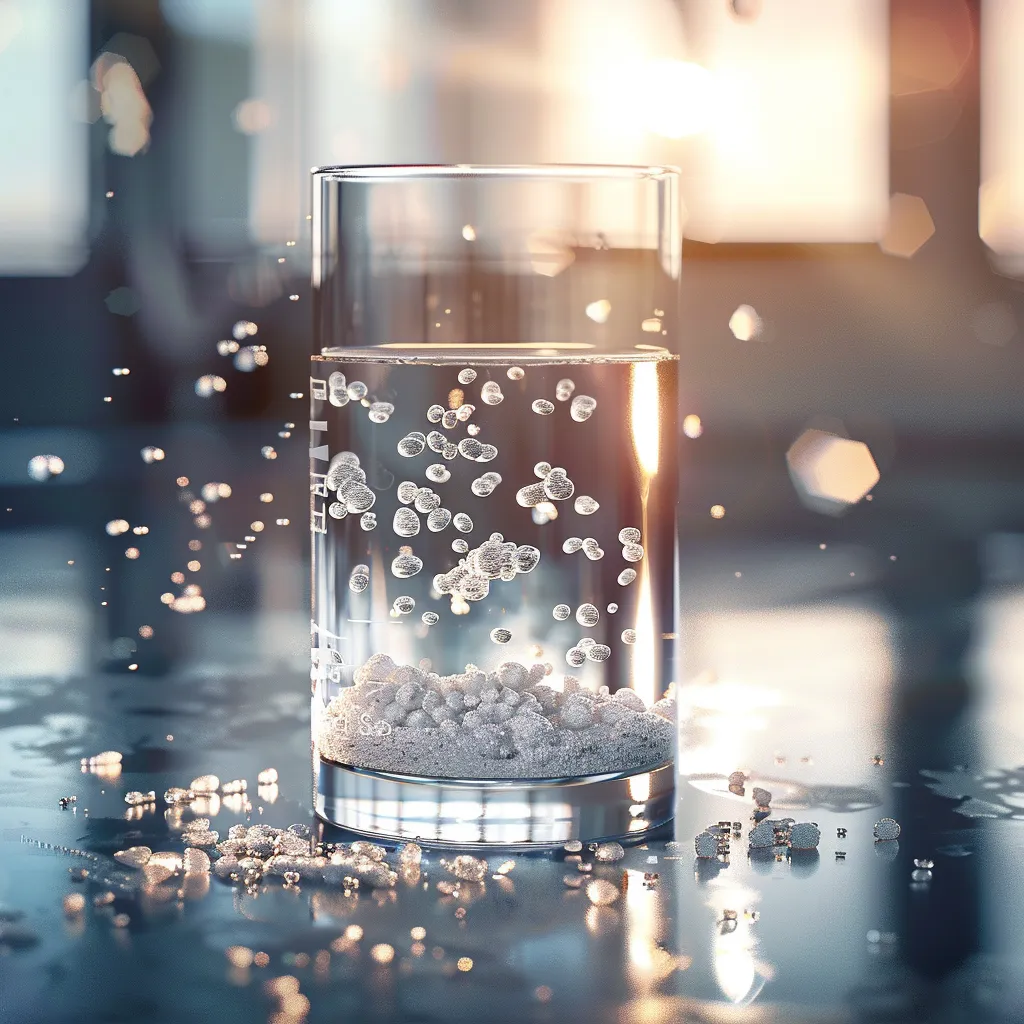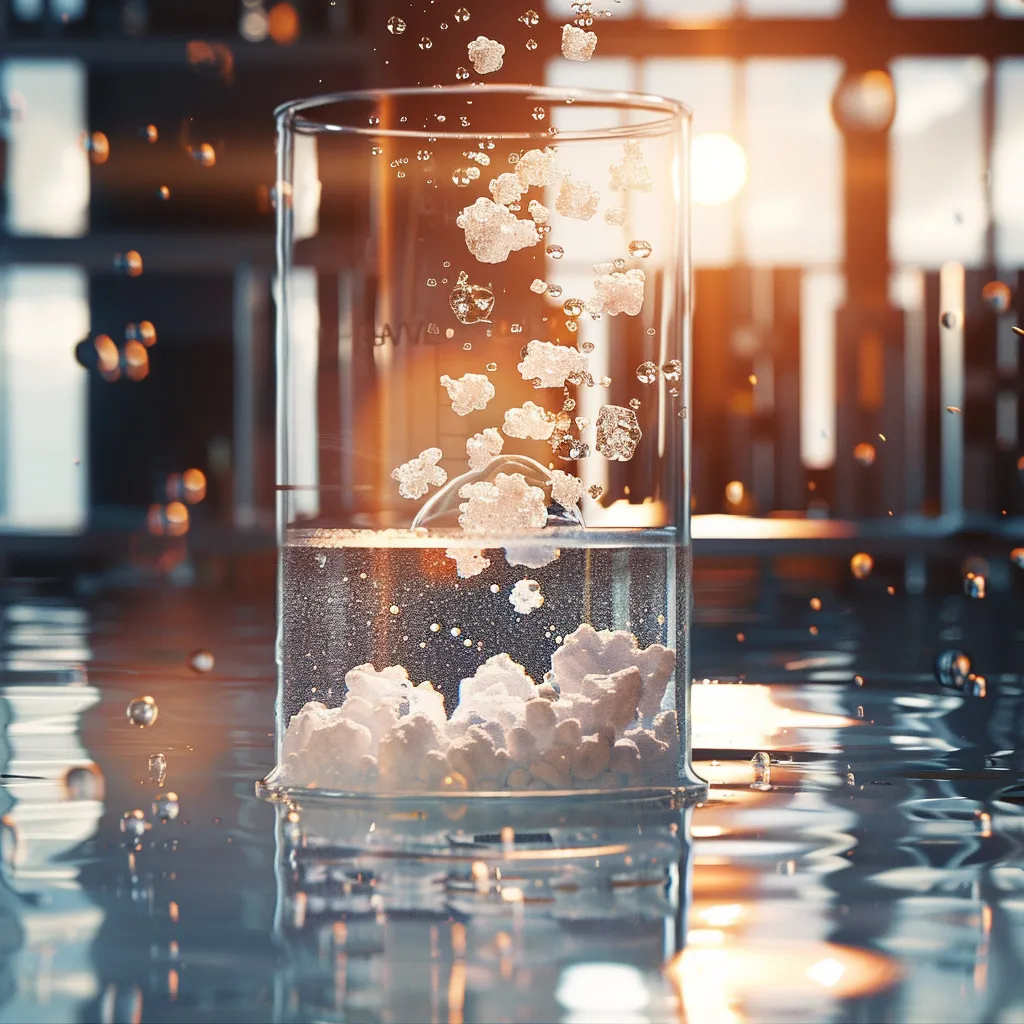
Solubility describes how much of a substance (solute) can dissolve in a solvent to form a solution.
It is an important concept in chemistry, as it determines how substances mix and interact. Factors like temperature, pressure, and the properties of the solute and solvent affect solubility.
We will explore the basics of solubility, including terms like solute, solvent, and solution. We’ll also look at what happens when a solution becomes saturated and how solubility differs from dissolution rate.
Solubility: Quick Summary
Do you just need the basics? Here’s a simple explanation of solubility:
🟠 Solubility refers to how much of a substance (solute) can dissolve in a solvent at a given temperature and pressure.
🟠 Saturated solutions contain the maximum amount of dissolved solute, while supersaturated solutions hold more solute than normal under certain conditions.
🟠 Solubility product ($K_{sp}$) is used to calculate the solubility of ionic compounds, predicting whether a solute will precipitate out of solution.
🟠 Henry’s Law explains that the solubility of gases in liquids increases with higher pressure.
If you find the solubility of the compounds challenging, don’t worry! Personalized tutoring or interactive chemistry lessons make these concepts more straightforward. Explore more chemistry topics and broaden your knowledge with our free World of Chemistry blogs.
What is Solubility?
Solubility is the maximum amount of solute that can dissolve in a solvent at a specific temperature and pressure, forming a homogeneous mixture. When this limit is reached, the solution is saturated, meaning no more solute can dissolve. If additional solute is added to a saturated solution, it will remain undissolved.
A solute can be a solid, liquid, or gas, and a solvent is typically a liquid, such as water.
For example, when you mix salt ($NaCl$) in water, it dissolves until the solution reaches saturation. Solubility depends on the chemical properties of both the solute and the solvent, as well as external factors like temperature.
Supersaturated solutions hold more solute than is normally possible at equilibrium and are unstable. Solubility is not the same as the rate of dissolution, which measures how fast a solute dissolves rather than the amount that can dissolve.
Factors Affecting Solubility
The solubility of a substance is influenced by various factors, including temperature, pressure, polarity, and particle size. Each of these factors affects how much of a solute can dissolve in a solvent under specific conditions.
1. Temperature
Temperature strongly impacts the solubility of solids, liquids, and gases. For most solids, solubility increases with higher temperatures.
For example, more sugar dissolves in hot water than in cold water. This occurs because higher temperatures increase the movement of solvent molecules, allowing them to break apart the solute more effectively.
The Van’t Hoff equation relates changes in solubility to temperature:
$\ln\left(\frac{K_2}{K_1}\right) = \frac{-\Delta H_{\text{sol}}}{R} \left( \frac{1}{T_2} – \frac{1}{T_1} \right)$
This equation helps predict the effect of temperature changes on the solubility constant $K_{sp}$, especially in endothermic reactions, where solubility typically increases with temperature.
For gases, solubility decreases as temperature rises. For instance, warm soda loses carbonation faster because the solubility of carbon dioxide decreases with increasing temperature, allowing the gas to escape from the liquid more easily.
Thus, temperature has a direct effect on solubility, and this relationship varies depending on the state of the solute—solid or gas.
2. Pressure
Pressure primarily affects gas solubility in liquids. Henry’s Law describes how gas solubility is proportional to the pressure of the gas above the liquid:
$C = k_P \cdot P$
$C$ represents the concentration of the dissolved gas, $k_P$ is Henry’s constant, and $P$ is the pressure.
For example, soda cans are pressurized to keep carbon dioxide dissolved in the liquid. When the can is opened, the pressure decreases, and the gas escapes, creating fizz. Unlike gases, the solubility of solids and liquids does not change significantly with pressure.
Gas solubility increases with pressure, making pressure an important factor in situations where gases need to remain dissolved.
3. Polarity
Polarity plays a major role in solubility based on the rule “like dissolves like.” Polar solvents dissolve polar solutes, while non-polar solvents dissolve non-polar solutes.
Water, a polar solvent, dissolves ionic compounds like sodium chloride ($NaCl$) because of the interaction between water’s partial charges and the ions in $NaCl$.
Non-polar substances like oil do not dissolve in water but will dissolve in non-polar solvents such as benzene.
Polarity determines how different solutes interact with solvents. It helps explain why certain substances mix easily while others remain separated in solutions.
4. Particle Size and Surface Area
The size of solute particles affects the rate at which they dissolve. Smaller particles dissolve faster because they have a larger surface area, allowing more solvent interactions.
The Noyes-Whitney equation explains this relationship:
$\frac{dm}{dt} = \frac{A \cdot D}{d} \left( C_s – C \right)$
$\frac{dm}{dt}$ represents the dissolution rate, $A$ is the surface area, $D$ is the diffusion coefficient, $d$ is the diffusion layer’s thickness, and $C_s$ and $C$ are the concentrations of the solute at the surface and in the bulk solution.
For example, powdered sugar dissolves faster than sugar cubes due to the greater surface area it exposes to the solvent.
Solubility of Different Substances
Substances’ solubility depends on whether they are ionic or covalent. Ionic compounds dissolve in polar solvents like water, while covalent compounds exhibit different solubility behaviors depending on their structure and the solvent used.
Solubility of Ionic Compounds
Ionic compounds dissolve in polar solvents such as water. This happens because water’s polar molecules interact with the charged ions in the compound.
For example, when sodium chloride ($NaCl$) dissolves in water, the $Na^+$ ions are attracted to the negative end of water molecules, and the $Cl^-$ ions are attracted to the positive end.
The solubility of ionic compounds can be quantified using the solubility product constant ($K_{sp}$).
For example, for silver chloride ($AgCl$): $K_{sp} = [Ag^+] \cdot [Cl^-]$
This constant helps calculate ion concentrations in a saturated solution and predict whether precipitation will occur when solutions are mixed.
Solubility of Covalent Compounds
Covalent compounds dissolve differently based on their polarity. Polar covalent compounds like sugar dissolve in polar solvents like water due to strong interactions between their polar molecules. On the other hand, non-polar covalent compounds, such as oil, do not dissolve in water but are soluble in non-polar solvents like hexane.
The solubility of covalent compounds depends on intermolecular forces. For instance, hydrogen bonding between molecules enhances solubility in water. However, non-polar substances do not interact well with polar solvents, leading to low solubility in water.
Saturated vs. Supersaturated Solutions
A saturated solution occurs when a solvent has dissolved the maximum solute possible at a specific temperature and pressure. At this point, any additional solute will not dissolve and remain as a solid.
For example, when salt is added to water, it dissolves until the solution becomes saturated, after which no more salt will dissolve.
A supersaturated solution contains more solute than what normally dissolves at equilibrium. This is achieved by dissolving excess solute at a higher temperature and tooling the solution slowly. Supersaturated solutions are unstable, and any disturbance can cause the extra solute to crystallize.
For example, a hot sugar solution can dissolve more sugar than at room temperature. When cooled carefully, it becomes supersaturated. Even a tiny disturbance, like adding a sugar crystal, can trigger crystallization.
To calculate solubility limits, the concentration of dissolved solute is compared to the solubility constant ($K_{sp}$). If the concentration exceeds the solubility limit, the solution becomes supersaturated.
Practical Applications of Solubility
- Purification of Substances: Solubility is used to separate mixtures through crystallization. By dissolving a mixture in a solvent, impurities can be removed as different components crystallize at different rates.
- Recrystallization: Solubility differences at varying temperatures help purify solids. For example, a solid can be dissolved in a hot solvent and then cooled to recrystallize the pure compound.
- Extraction: Solubility enables the extraction of compounds from mixtures, such as using water to extract caffeine from tea leaves.
- Water Treatment: Solubility principles are used to remove dissolved substances from water. Chemicals are added to precipitate unwanted ions, making them insoluble and easier to filter.
- Manufacturing: Many industries use solubility in producing materials, including creating solutions for coatings, adhesives, and cleaning agents.
- Agriculture: Solubility affects how fertilizers dissolve in soil water, impacting plant nutrient availability
Sample Problems and Calculations
🟠 Solubility Exercise 1
Calculate the solubility of silver chloride ($AgCl$) in water using its solubility product constant ($K_{sp}$).
Given $K_{sp} = 1.8 \times 10^{-10}$ for $AgCl$, the equation is:
$K_{sp} = [Ag^+] \cdot [Cl^-]$
Since $[Ag^+] = [Cl^-]$
$K_{sp} = s^2$
where $s$ is the solubility.
Solving for $s$:
$s = \sqrt{1.8 \times 10^{-10}} = 1.34 \times 10^{-5}$ mol/L
🟠 Solubility Exercise 2
Using Henry’s Law, calculate the solubility of oxygen in water at a pressure of 2 atm.
Given $k_P = 1.3 \times 10^{-3}$ mol/L·atm:
$C = k_P \cdot P = 1.3 \times 10^{-3} \times 2 = 2.6 \times 10^{-3}$ mol/L
Solubility of Compounds in Water
| Compound Type | Soluble in Water | Insoluble in Water |
| Nitrates (NO₃⁻) | Soluble in water | None |
| Chlorides (Cl⁻) | Soluble (except Ag⁺, Pb²⁺, Hg₂²⁺) | Silver chloride ($AgCl$), lead chloride ($PbCl_2$) |
| Sulfates (SO₄²⁻) | Soluble (except Ba²⁺, Sr²⁺, Pb²⁺, Ca²⁺, Hg₂²⁺) | Barium sulfate ($BaSO₄$), lead sulfate ($PbSO₄$), calcium sulfate ($CaSO₄$) |
| Carbonates (CO₃²⁻) | Insoluble (except Group 1 metals and ammonium, $NH₄^+$) | Calcium carbonate ($CaCO₃$), magnesium carbonate ($MgCO₃$) |
| Phosphates (PO₄³⁻) | Insoluble (except Group 1 metals and ammonium, $NH₄^+$) | Calcium phosphate ($Ca₃(PO₄)₂$) |
| Hydroxides (OH⁻) | Insoluble (except Group 1 metals, ammonium, $Ba(OH)_2$, and $Sr(OH)_2$) | Aluminum hydroxide ($Al(OH)_3$), iron(III) hydroxide ($Fe(OH)_3$) |
| Sulfides (S²⁻) | Insoluble (except Group 1, Group 2 metals, and ammonium, $NH₄^+$) | Lead sulfide ($PbS$), copper(II) sulfide ($CuS$) |
| Acetates (CH₃COO⁻) | Soluble | None |
| Ammonium Compounds | All ammonium compounds ($NH₄^+$) are soluble | None |
| Group 1 Metal Compounds | Soluble (lithium, sodium, potassium, rubidium, cesium salts) | None |
| Fluorides (F⁻) | Soluble (except Pb²⁺, Mg²⁺, Ca²⁺, Ba²⁺) | Lead fluoride ($PbF₂$), magnesium fluoride ($MgF₂$), calcium fluoride ($CaF₂$) |
| Oxalates (C₂O₄²⁻) | Insoluble (except Group 1 metals and ammonium, $NH₄^+$) | Calcium oxalate ($CaC₂O₄$), magnesium oxalate ($MgC₂O₄$) |
| Chromates (CrO₄²⁻) | Insoluble (except Group 1 metals, ammonium, and $CaCrO₄$) | Lead chromate ($PbCrO₄$), barium chromate ($BaCrO₄$) |
Advance Your Knowledge of Solubility
Is the solubility of substances tricky for you? A qualified chemistry instructor can explain complex topics in a way that makes sense to you, making organic and inorganic chemistry understandable and enjoyable.
Search for a tutor using phrases like “organic chemistry tutor Liverpool” or “inorganic chemistry teacher Edinburgh” on platforms like meet’n’learn. You’ll find someone who can tailor lessons to your needs.
If you prefer learning in a group, search for “chemistry classes Leeds” or “chemistry lessons London” online. The search will lead you to chemistry tutoring nearby.
Solubility of the Substances: Frequently Asked Questions
1. What is solubility in chemistry?
Solubility is the maximum amount of a solute that can dissolve in a solvent under specific temperature and pressure conditions.
2. What factors affect solubility?
Solubility is influenced by temperature, pressure, the polarity of the solute and solvent, and the particle size of the solute.
3. What is a saturated solution?
A saturated solution occurs when a solvent has dissolved the maximum possible amount of solute at a given temperature and pressure.
4. What is a supersaturated solution?
A supersaturated solution contains more solute than typically dissolves in a solvent at equilibrium, and it is usually achieved by heating and slowly cooling the solution.
5. How is solubility calculated?
We calculate solubility using the solubility product constant ($K_{sp}$) for ionic compounds or Henry’s Law for gases.
6. What is the difference between solubility and dissolution rate?
Solubility measures how much solute can dissolve, while dissolution rate measures how quickly a solute dissolves in a solvent.
7. How does temperature affect gas solubility?
As temperature increases, gas solubility in liquids typically decreases, allowing gases to escape more easily.
8. What is Henry’s Law?
Henry’s Law states that the solubility of a gas in a liquid is proportional to the gas’s partial pressure above the liquid.
References:
1. Wikipedia
2. UEN
3. LibreTexts Chemistry



